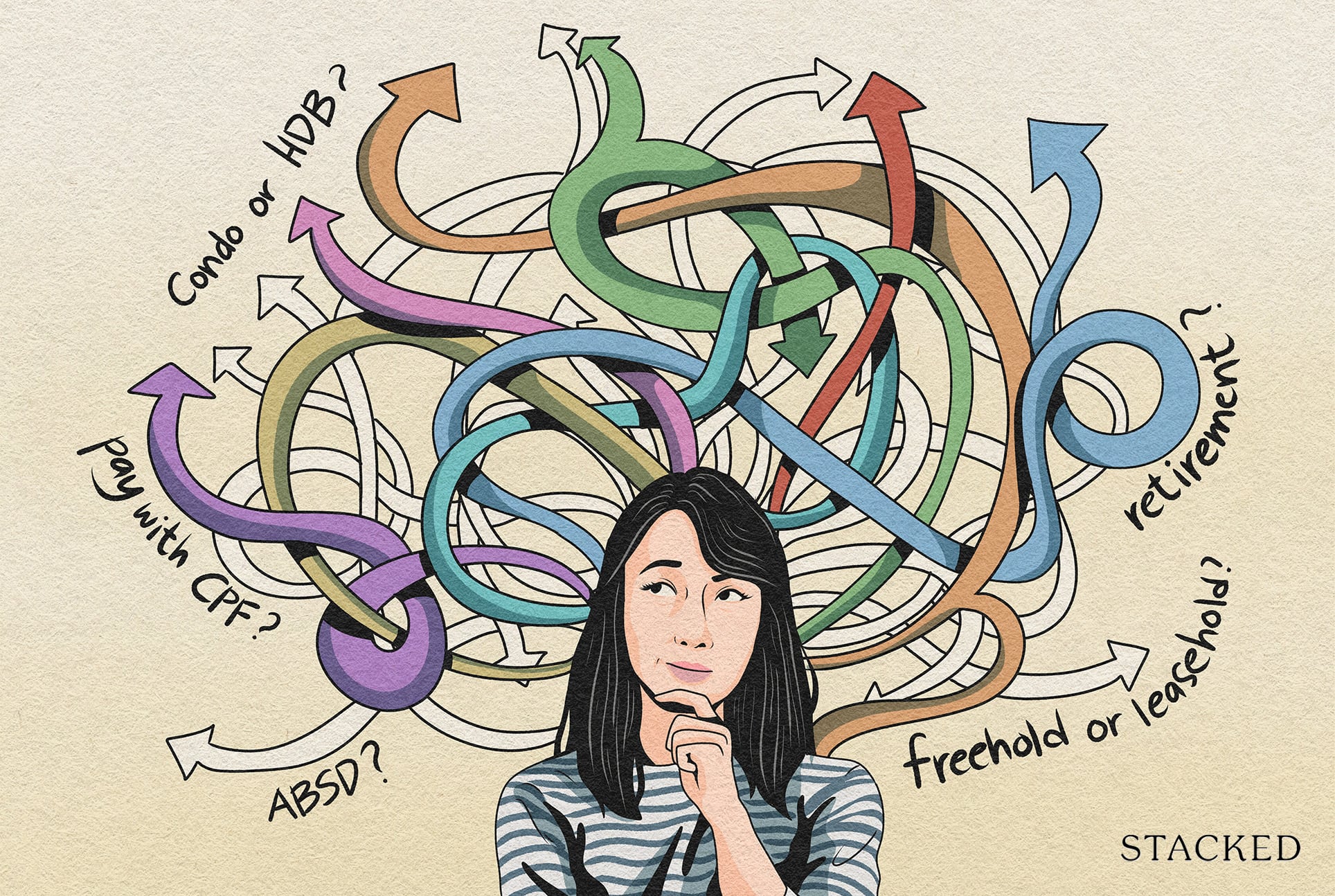5 Mental Models To Rethink Your Property Investment Choice In Singapore

Get The Property Insights Serious Buyers Read First: Join 50,000+ readers who rely on our weekly breakdowns of Singapore’s property market.
Some people call them mental models. Some call it frameworks.
To me, it is simply a way to think about the world and the evolving situation.
I adopt mental models as a way to focus on the important levers – the key anchors that will make an important difference in any decision-making process.
In the context of the Singapore property market, what works for our parents’ generation will no longer work for us.
Here are 5 mental models to guide you as you think about your next property move.
Mental Model #1: Becoming the Last Sandwich Generation
For some of us in Singapore, we become stuck in between as we juggle careers, children, and aging parents.
We are deemed the sandwich generation as we figure out how to prioritize between competing needs and heavy responsibilities. Being a caregiver for 2 different generations can be taxing – both mentally and financially.
While this is a difficult situation to be in, it can also be a powerful mental model as it can be used to galvanize, gather our resources and motivate ourselves.
For some parents, it is about making sure that our children never become the next sandwich generation.
Being fully resolute about not depending on our children for our own retirement will force us to become more strategic in building up our own savings and our retirement nest egg.
We can make the conscious and active decision to become the last sandwich generation – by making quality decisions on our property choices and by taking strategic action early.
Mental Model #2: Your Retirement Is Within Your Property

This brings us to the next mental model about retirement in Singapore.
We can safely say that the majority of Singaporeans will finance their first property through the monies from their CPF OA.
Unless you are self-employed with limited CPF contributions, you are likely to pull out a significant portion of your CPF OA and park it in your first home.
Like it or not, you are essentially borrowing from your retirement at a cost of 2.5% interest.
This does not include the costs of your housing loan.
If you took up a housing loan with a rate of 2% interest, that means your total opportunity costs increase to 4.5%.
If your property prices rise by 4.5% per year, you will essentially break even.
If your property prices remain stagnant, you will lose 4.5% per year.
If your property prices drop 1% per year, you will lose 5.5% per year.
Being aware of this buildup of CPF accrued interest is important – otherwise, you might lose track of how depleted your retirement nest egg has become.
You also need to be able to keep track of the performance of your own property – so you know whether its value is depreciating or increasing.
It doesn’t matter if it’s private property or HDB – the same rules apply.
Unfortunately, most people get this rude awakening only when they decide to sell their homes.
Find out if your property is “performing” and whether is it covering the “costs” of the loan you took.
Mental Model #3: ABSD Is Here To Stay
ABSD is a form of cooling measure that was first released in 2011 and became more punitive in 2013.
In 2013, you would only need to pay 7% ABSD for your 2nd property onwards as a Singapore citizen.
In 2021, the ABSD rate was revised to 17%.
It is a great deterrent on property speculation.
It also stops people from owning multiple properties.
It is not worth paying that 17%, as that 17% could have been part of your property gains instead.
What it means is this: You only have 1 chance to get the best property choice.
The most bang for your buck.
Once your name is attached to a property, you are sort of stuck until you decide to sell.
Since you are going to park a lot of money into your residential home anyway, this means you really have to think about how to make full use of this 1 chance.
Make the right choice and you essentially stay for free and make some money out of it.
Make the wrong choice and you will be paying for that mistake for years to come.
More from Stacked
How To Properly Plan Your Timeline When Upgrading To A Resale Condo (Move Once And Avoid ABSD)
One of the main hassles of upgrading that many people don’t think about is the timeline. From getting the sale…
That is leveraged returns for you.
It can be very good or very bad.
Mental Model #4: You Don’t Know What You Don’t Know
Being self-aware of our own limitations is key to achieving our goals.
I covered this in detail here about how humility is the greatest investment strategy and being aware of our gaps and blindspots is necessary to achieve an investment goal.
Despite working with various property agents for the past 7 years, I do not consider myself an expert in selecting the best property that will bring me the best returns.

Instead, I will be too focused on selecting a home that matches my family’s needs instead of considering future financial returns.
So someone – preferably an agent with a proven track record, experience, and expertise is necessary to guide me on the pitfalls and issues that certain properties might face.
For example, a development with thin transaction volumes becomes very tricky to sell – bank valuation is an issue as the most recent transaction might be from a few years ago.
And how do I know this?
Only after an experienced agent shared this information with me.
So no matter how good at the research I might be, it can never beat the experience of someone who is on the ground every single day – talking to buyers, sellers, tenants, and homeowners.
Mental Model #5: We Will Grow Older
This might be morbid to think about.
But I consider Stephen Covey’s Effective Habit #2 which is “Begin With The End In Mind” as a good form of guidance and reminder.
As we grow old, our choices become more limited.
Here are some of the things that might happen:
- our earning ability falters
- our ability to take up loans becomes limited
- our physical bodies fail
If you are at the age of 35, you can take up a loan tenure of 30 years.
If you are at the age of 45, your loan tenure is only 20 years. It also means higher monthly repayments and this could affect your cash flow.
As Oliver Burkeman mentions in his book “Four Thousand Weeks: Time Management for Mere Mortals”:”…mortality makes it impossible to ignore the absurdity of living solely for the future.
Where’s the logic in constantly postponing fulfillment until some later point in time when soon enough you won’t have any “later” left?”
So don’t delay and don’t procrastinate.

There is only so much time we have left to fulfill our dreams and goals.
Want that dream home or dream retirement lifestyle? Focus on what steps you have to take to get there with whatever time you have left.
(The title of the book “Four Thousand Weeks” – refers to the average lifespan we humans have. )
Final Words
In the long term, we are all dead.
Thinking about death is a form of memento mori and it is a good mental exercise that provides clarity about what is truly important in life.
Financial figures and hard-headed analysis are all important but to provide a balance in life – you do have the consider what truly matters in the end.
Doing our own research, figuring things out ourselves, and making mistakes in our own financial journey is all good – as long as we are learning something in the process.
But if the journey is not generating any new valuable insights or breakthroughs in your decision-making process – perhaps it is time to talk to someone who has the experience, knowledge, and expertise to help you.

This year, inflation is expected to become worse. That basically means our liquid assets are degrading in value in real-time.
The first-hand shock of seeing how little S$50 can buy you in the supermarket or how much the costs of petrol have jumped – is numbing at first.
But it should also shock you into action.
Property can be a good hedge against the tide of rising inflation.
Have questions on your own property options? Keen to explore what is possible for you?
Drop us a message and our team at Stacked will do our best to help you.
If you’d like to get in touch for a more in-depth consultation, you can do so here.
Aidah
Aidah Omar is a marketing consultant and digital strategist for various SMEs in Singapore for the past 8 years. Over the last 5 years, she has worked with property agents from various agencies. She has a 2-year old daughter who is obsessed with dinosaurs and Peppa Pig.Read next from Property Market Commentary

Property Market Commentary Why This Once-Ulu Town In Singapore Is Going To Change (In A Big Way)

Property Market Commentary I Lived In Bayshore When It Was ‘Ulu’. Here’s How Much It Has Changed

Property Market Commentary Why The Singapore Property Market Will Be Different In 2026 — And It’s Not Just About Prices

Property Market Commentary 2025 Year-End Review Of The Singapore Property Market: What The Numbers Reveal
Latest Posts

Pro How A 625-Unit Heartland Condo Launched In 2006 Became One Of 2025’s Top Performers

Property Investment Insights Does Buying A One-Bedroom Condo Still Make Sense As An Investment In 2026

Singapore Property News This HDB Just Crossed $1.3M For The First Time — In An Unexpected Area

Singapore Property News “I Never Thought I’d Be Sued by a Tenant.” What Long-Time Landlords in Singapore Miss

Singapore Property News HDB Resale Prices Finally Slowed in 2025 — Will It Continue in 2026?

Singapore Property News Breaking News: District 23 Condo Sells Out In Under Two Years At $2,120 Psf Average

On The Market Here Are The Cheapest 3-Bedroom Condos in Central Singapore You Can Still Buy From $1.15M

Pro This 21-Year-Old Condo Didn’t Sell Out Initially, Yet Became A Top Performer

Editor's Pick What I Only Learned After My First Year Of Homeownership In Singapore

Singapore Property News Why More Land Doesn’t Automatically Fix Housing In Singapore

On The Market Here Are The Cheapest 4-Room HDB Flats in Central Singapore You Can Still Buy From $490K

Editor's Pick Should We Buy An Old 99-Year Leasehold Condo To Live In: Will It’s Value Fall When The Lease Runs Out?

Pro How A Once “Ulu” Condo Launched In 1997 Became A Top Performer

Editor's Pick I Reviewed A New Launch 4-Bedroom Penthouse At Beauty World

Editor's Pick Why Singaporean Families Are Looking At This Landed Enclave From Around $4M



Regarding mental model #2, is your calculations correct ? I make a simple example, says a 1mil property. 25% CPF + 75% bank loan. CPF loss interest 2.5% = 6250, Bank interest 2% = 15000. Total is 21250 divided by 1mil = 2.125%. Did I overlook anything ?